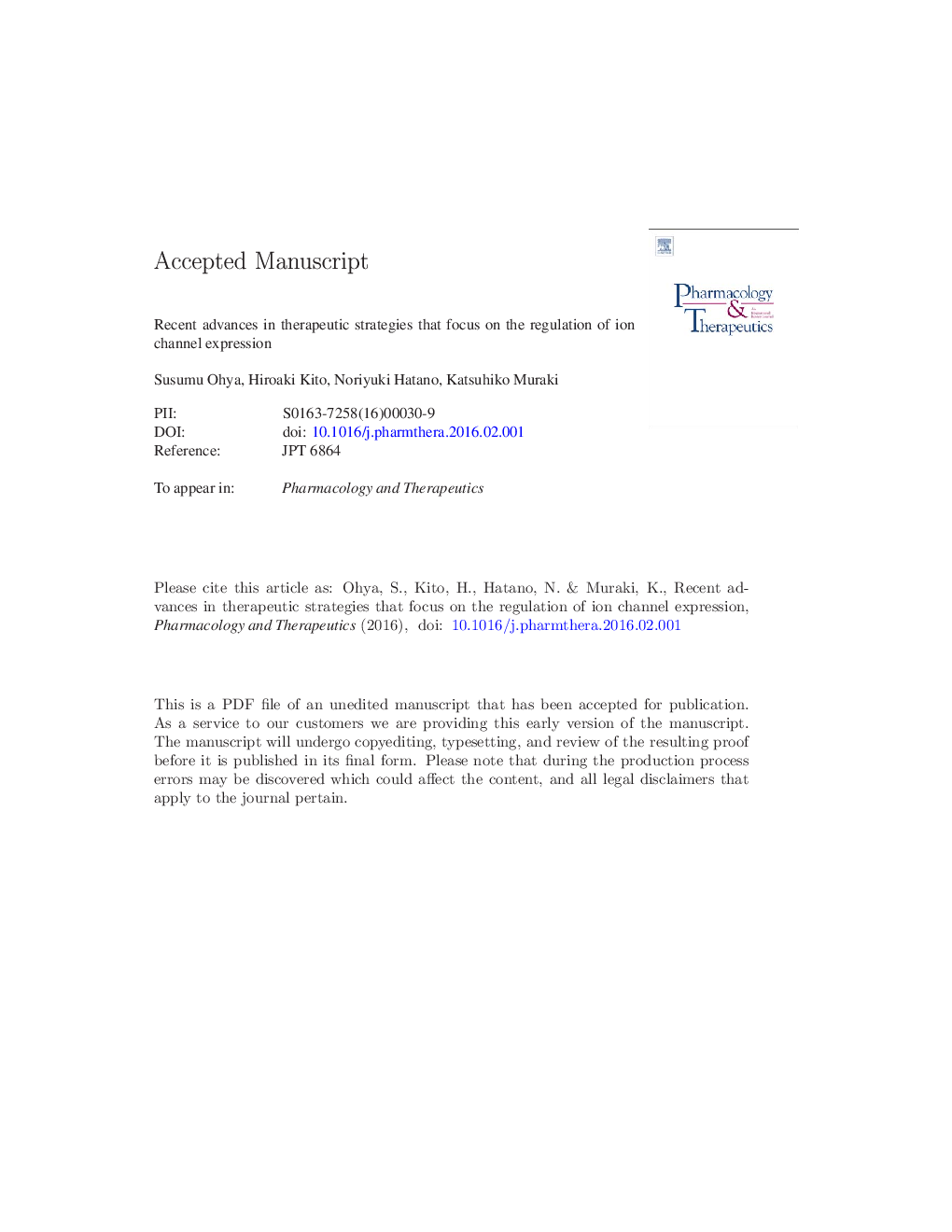| Article ID | Journal | Published Year | Pages | File Type |
|---|---|---|---|---|
| 5843892 | Pharmacology & Therapeutics | 2016 | 171 Pages |
Abstract
A number of different ion channel types are involved in cell signaling networks, and homeostatic regulatory mechanisms contribute to the control of ion channel expression. Profiling of global gene expression using microarray technology has recently provided novel insights into the molecular mechanisms underlying the homeostatic and pathological control of ion channel expression. It has demonstrated that the dysregulation of ion channel expression is associated with the pathogenesis of neural, cardiovascular, and immune diseases as well as cancers. In addition to the transcriptional, translational, and post-translational regulation of ion channels, potentially important evidence on the mechanisms controlling ion channel expression has recently been accumulated. The regulation of alternative pre-mRNA splicing is therefore a novel therapeutic strategy for the treatment of dominant-negative splicing disorders. Epigenetic modification plays a key role in various pathological conditions through the regulation of pluripotency genes. Inhibitors of pre-mRNA splicing and histone deacetyalase/methyltransferase have potential as potent therapeutic drugs for cancers and autoimmune and inflammatory diseases. Moreover, membrane-anchoring proteins, lysosomal and proteasomal degradation-related molecules, auxiliary subunits, and pharmacological agents alter the protein folding, membrane trafficking, and post-translational modifications of ion channels, and are linked to expression-defect channelopathies. In this review, we focused on recent insights into the transcriptional, spliceosomal, epigenetic, and proteasomal regulation of ion channel expression: Ca2+ channels (TRPC/TRPV/TRPM/TRPA/Orai), K+ channels (voltage-gated, KV/Ca2+-activated, KCa/two-pore domain, K2P/inward-rectifier, Kir), and Ca2+-activated Clâ channels (TMEM16A/TMEM16B). Furthermore, this review highlights expression of these ion channels in expression-defect channelopathies.
Keywords
AMPKNF-κBPI3KEGFlncRNADRGNFATPAHTrpATISUMOPAMHDACHUVECSRFpKaCaMKNGFIP3NMDAP-1HDACiAITCTRPAPKCTRPVKirTGFHSF1ANGIIHIFHRENRSFARFTRPMPHDMITFVDREADPRKCaESCRTRunx1AKAPTRPCLNCaPK2Pandrogen responsive elementCa2+-activated Cl− channelLQTWNKNHERF-1TNFTwo-pore domain K+ channelADP ribosedorsal root ganglion5′ AMP-activated protein kinaseinositol 1,4,5-trisphosphateK+ channelMAPKLong QT long non-coding RNASGKHydrogen peroxidealternative translation initiationSTATAngiotensin IIAllyl isothiocyanatechromatin immunoprecipitationAlzheimer's diseasetransforming growth factorProtein degradationElectrophoretic Mobility Shift CNSTranscriptionCAMHuman umbilical vein endothelial cellEMSA یا electrophoretic mobility shift assay Ubiquitin-proteasome systemcentral nervous systemendoplasmic reticulumSNAPneuron-restrictive silencer factorEpithelial growth factorrunt-related transcription factor 1heat shock factor 1nuclear factor of activated T-cellsHypoxia responsive elementADP-ribosylation factorHypoxia-inducible factornerve growth factorMicrophthalmia-associated transcription factortumor necrosis factornuclear factor-κBserum response factornonsense-mediated mRNA decayphosphoinositide 3-kinasePulmonary arterial hypertensionSignal transducer and activator of transcriptionendosomal sorting complex required for transporthistone deacetylase inhibitorCANMicroRNAMiRNAAREH2O2histone deacetylasetransient receptor potentialA-kinase anchoring proteinactivator protein-1synaptosomal-associated proteinprotein kinase AProtein kinase Cmitogen-activated protein kinaseCa2+/calmodulin-dependent protein kinaseProlyl hydroxylasepre-mRNA splicingSingle-nucleotide polymorphismSNPCHiPcaveolin-1CalmodulinCa2+ channelVoltage-gated K+ channelCa2+-activated K+ channelCav-1Calcineurinsmall ubiquitin-like modifierAndrogen ReceptorUPS
Related Topics
Health Sciences
Pharmacology, Toxicology and Pharmaceutical Science
Pharmacology
Authors
Susumu Ohya, Hiroaki Kito, Noriyuki Hatano, Katsuhiko Muraki,
